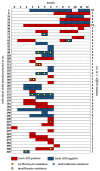Antimicrobial Resistance Patterns in Clostridioides difficile Strains Isolated from Neonates in Germany
- PMID: 32759868
- PMCID: PMC7460221
- DOI: 10.3390/antibiotics9080481
Antimicrobial Resistance Patterns in Clostridioides difficile Strains Isolated from Neonates in Germany
Abstract
Young children are frequently colonized with Clostridioides (C.) difficile. Depending on their resistance patterns, antibiotic treatment can facilitate gastrointestinal spreading in colonized individuals, potentially leading to transmission to others. C. difficile was isolated from stool samples from infants born in two hospitals in Göttingen and Darmstadt, Germany. All isolates were subjected to phenotypic antimicrobial resistance testing, PCR-based screening for toxin genes and mass spectrometry-based exclusion of ribotypes 027 and 176. Within an initial cohort of 324 neonates with a longitudinal survey of C. difficile, 137 strains were isolated from 48 individuals. Antimicrobial resistance was recorded against metronidazole in one (0.7%), erythromycin in 16 (11.7%) and moxifloxacin in 2 (1.5%) of the strains, whereas no resistance was observed against vancomycin (0.0%) or rifampicin (0.0%). Newly observed resistance against erythromycin in children with detection of previously completely sensitive isolates was reported for C. difficile isolates from 2 out of 48 children. In 20 children (42%), non-toxigenic strains were detected, and from 27 children (56%), toxigenic strains were isolated, while both toxigenic and non-toxigenic strains were recorded for 1 child (2%). Ribotypes 027 or 176 were not observed. In conclusion, the German C. difficile strains isolated from the children showed mild to moderate resistance with predominance of macrolide resistance, a substance class which is frequently applied in children. The observed switches to the dominance of macrolide-resistant isolates suggests likely selection of resistant C. difficile strains already in children.
Keywords: Clostridioides difficile; Germany; antibiotic resistance; children; selection.
Conflict of interest statement
The authors declare no conflicts of interest.
Figures

References
Grants and funding
LinkOut - more resources
Full Text Sources

